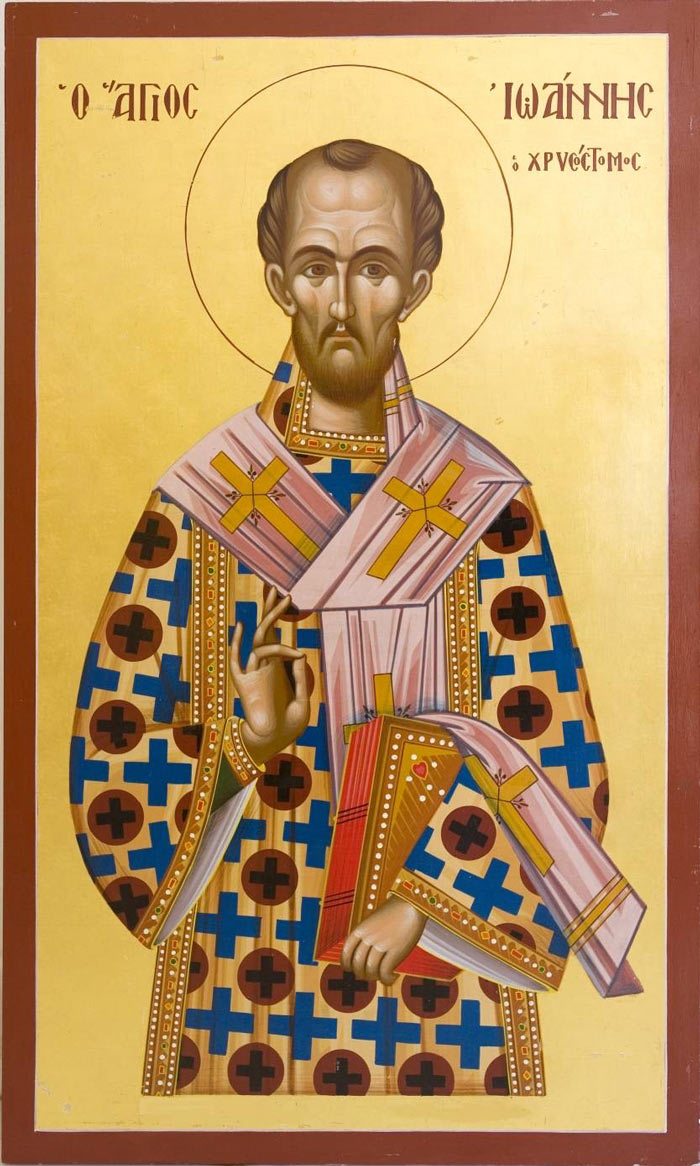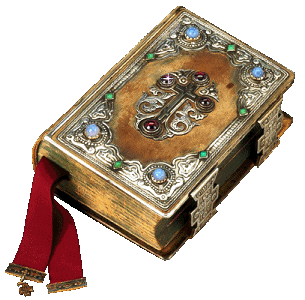
On January 27th, our Church commemorates the Transfer of the Holy Relics of St. John Chrysostom, Archbishop of Constantinople. He is widely known, as we often celebrate the Divine Liturgy that bears his name in all Orthodox churches. He was born in Great Antioch of Syria (today’s Antakya of Turkey) in the year 347 AD. His father died soon after his birth, leaving him to be raised by his Christian mother, Anthusa (who is also honored as a saint). He studied Rhetoric and Theology with the great teachers of Antioch. Later, he left the city for desert, where he devoted himself to an ascetic life and deep study of the Holy Bible. In 381 he returned to Antioch, where he was ordained a deacon and later priest. After his ordination, he distinguished himself in the exegesis of Scripture, sermons, and other pastoral activities. His fame soon extended beyond the borders of Antioch, and in 397 he was elected Archbishop of Constantinople. His homilies captivated the people, and this is why he is known as St. John “Chrysostom” (the man with the golden mouth). His wonderful homilies and epistles have survived to this day.
As the Archbishop of the imperial capital, he worked towards the spiritual edification of the faithful, and for their understanding of the liturgical treasures of the Church (in particular the Divine Liturgy, of which he strived to increase conscientious participation). He also took on the protection of the poor and to care for those in need with whatever they required for survival. With his sermons, St. John harshly criticized the wasteful living of the rich, and condemned any kind of abuse, with no regard for social class. He did not hesitate to stand against even the Empress Eudoxia for her lawlessness and injustice. As a result, he was exiled twice. On the way to his second exile, he died at Comana of Pontus (due to the hardship) on September 14th, 407 at the age of 60.
When we examine the life of St. John Chrysostom, a life full of bitterness, persecution, and exile, we remain amazed by his endurance and patience in facing them. He confronted all of this with a forbearance and spiritual peace that can’t help but amaze. He understood in depth the words of the Lord: “If they persecuted Me, they will also persecute you” (John 15:20). What can be more natural than this? St. John was not surprised by the persecutions, but rather he gained strength from the Lord’s word: “Blessed are those who are persecuted for righteousness’ sake” (Matthew 5:10). A persecuted Christian is happy, because they are working for Christ and His Church! This is why St. John Chrysostom remained at peace, because his conscience was clear, as he was suffering for Christ and with Christ. He felt a spiritual calm in having the privilege to suffer in this way, for Christ, just as St. Paul the Apostle wrote to the Christians of Philippi who were being persecuted: “To you it has been granted on behalf of Christ, not only to believe in Him, but also to suffer for His sake”! (Philippians 1:29). St. Paul calls the persecutions a “grant,” and this is why St. John Chrysostom felt indebted to God for all the hardships. It is with such feelings that in his exile, he gave up his spirit to God, saying: “Glory be to God for all things!” God glorifies those who glorify Him, and did not leave his faithful servant to be forgotten. God rewarded his patience, endurance, and sanctity by restoring his memory in a glorious and triumphant way. How did this happen?
After sending the saint into exile, the Empress Eudoxia fell ill with a very serious and incurable disease. Worm infested wounds covered her whole body and she died in a horrible state of agony. Even after her death, her bier was shaking day and night inside the tomb where it was placed.
In 438, Eudoxia’s son Emperor Theodosius II, responded positively to the petition of the then Archbishop of Constantinople St. Proclus to return St. John Chrysostom’s relics to Constantinople from Comana. This was to be done with great honor and ceremony. The Emperor himself welcomed and venerated the relics of the Saint, utterly contrite and in awe. On January 27th, a glorious procession carried the holy Relics to the Church of St. Irene, where they were placed in the holy Synthronon (the semi-circular area behind the Holy Altar where there are thrones for the co-celebrant bishops). The people cried out “Reclaim your throne, O Saint!” Afterwards, an imperial carriage transported the Relics to the Church of the Holy Apostles where the burial took place. Only then did Eudoxia’s bier stop trembling!
My brothers and sisters, after reflecting on all of this, what can we see? On one side there is the all-powerful and exceedingly wealth Empress Eudoxia persecuting the Archbishop St. John Chrysostom. What a horrible end for her! On the other side, we see the poor one, with no earthly power whatsoever, the exiled saint returning to the Archbishop’s throne and being enthroned in the hearts of all Christians. God granted him the crown of sainthood! Which side do we want to be on? If on the side of St. John Chrysostom, then let us not be depressed or despondent when we suffer persecution or injustice inflicted by evil people. Let us not surrender to the sorrows that others may cause, and instead face them patience and indulgence, turning towards the face of Christ who suffered much worse than we did. May we be confident that such things contribute to our sanctification, securing for us “a far more exceeding and eternal weight of glory” (2 Corinthians 4:17).





